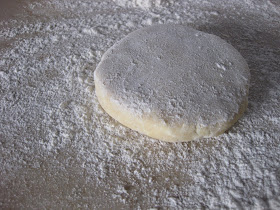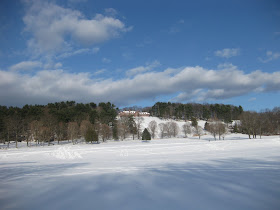
I came across this recipe for pear pie in the Harvest 2009 issue of edible Vineyard. edible Vineyard is one of 50 + Edible magazines published under the umbrella of Edible Communities Publications. Co-founded in 2002 by Tracey Ryder and Carole Topalian in Ojai, California, Edible Communities’ mission is “to transform the way consumers shop for, cook, eat and relate to local food.” I pick up every Edible title I can find, wherever I go. It’s one of the best ways to learn about a city's or region’s authentic local food scene and to connect with restaurants, farmers and shops that have the best ingredients.
Martha’s Vineyard, where edible Vineyard is published, is a locavore’s dream. The island is dotted with many small, organic farms that provide everything from honey and strawberries to grass-fed lamb and raw milk. A restoration of an organic cranberry bog from the 19th century is underway and there is an Agricultural Society that holds a Fair every summer, complete with livestock shows, horse pulls, and oyster shucking contests. Considering all the wealthy summer visitors that inhabit Martha's Vineyard over the summer, it is amazing the island still retains the charm and beauty of a slower time.
Those that do live there year round are a resourceful, self-sufficient bunch who know how to make the most of the natural bounty of the land and surrounding seas. This creativity is reflected in edible Vineyard’s articles and recipes.
The recipe is from Judi Worthington, a year-round Vineyarder. She started selling her pies at the West Tisbury Farmer’s Market back in the early ‘90’s and is known for using only the best and freshest ingredients. Bill Clinton celebrated his 60th birthday eating one of her pies; I celebrated the New Year making one one of them.

Double-Crust Winter Pear Pie with Maple, Brandy, Walnuts, and Cranberries
Adapted from edible Vineyard
Truth be told, I’ve never been a huge fan of pears. But I adore cranberries and fruit pies in general so I gave this pear pie a second look. Plus, it was from the Vineyard, one of my favorite places, and that alone made me want to try it!

The recipe calls for Comice pears, which I discovered are known for their juiciness and flavor. The magazine article gave a useful tip for picking out ripe pears: “A pear that’s just right for pie baking will be ripe but still firm (not soft) – you will be able to make just the slightest indent with your thumb if you press the skin.” If you can’t find Comice pears, they suggest Bartletts or D’Anjous.
I’m okay at rolling out pie crust but certainly not a pro. I have made enough, though, to know this dough is heavenly to work with and wonderfully flaky and buttery once baked.

Lastly, the original recipe strongly calls for pear brandy in the filling, which I didn’t have. Faced with one selection at the local liquor store that cost $65.00 (I needed 3 tablespoons), I decided to pass. We had Calvados (apple brandy) at home so I used that instead and it worked out great. Don’t be afraid to improvise. As my mom always says “If it has good things in it, why wouldn’t it taste good?”

Ingredients
For the pie dough
2¾ cup (12 ½ oz.) all-purpose flour
2 tsp. granulated sugar
¼ tsp. table salt
½ lb. (16 tbsp.) unsalted butter, cold, cut into ½-inch cubes
1/3 cup cold water
For the filling and assembly
2¼ to 2½ lbs. ripe Comice pears (about 4 to 5)
½ cup raisins or dried cranberries
½ cup coarsely chopped walnuts (optional)
1/3 cup maple syrup
3 tablespoons pear brandy (such as Poire William or Belle de Brillet) or 1 tablespoon vanilla extract plus 1 teaspoon fresh lemon juice
2 tbsp. minute tapioca
Flour as needed for rolling dough
1 large egg, white and yolk separated
Turbinado or other coarse sugar
Make the pie dough
Put the flour, sugar, salt, and butter in the bowl of a stand mixer fitted with a paddle (I used a food processor). Mix on medium-low speed until the mixture looks mealy and the largest butter pieces are the size of a flattened pea (about 1 1/2 minutes).

With the mixer running, drizzle in the water and mix until the dough has formed large, rounded crumbs and starts to pull away from the sides of the bowl; this will happen quickly. (If the mixture stays together when pinched, the dough is ready, if not, and it looks dry, add up to 2 more tablespoons of water, a teaspoon or two at a time.) Turn the dough out onto a lightly floured surface and shape it into two 5-inch disks. Wrap the dough in plastic and refrigerate while making the filling.

Assemble the pie
Heat the oven to 400 degrees. Core and thinly slice the pears (peeling is optional). In a large mixing bowl, combine the sliced pears, raisins or cranberries, walnuts (if using), maple syrup, brandy (or the vanilla extract and lemon juice), and the tapioca. Toss together well. Let sit, tossing occasionally, while you roll the dough.


Roll out the second disk of chilled dough into a 13-inch circle. Transfer the dough to the pie and arrange it over the filling. Trim the top dough so that it overhangs the bottom dough by ¼-inch. Seal the two layers of dough together by rolling the top over the bottom and then folding the two under along the edge of the pan. Flute the edge of the pie crust with your fingers or crimp with a fork. Make five or six slits in the top of the pie crust with a sharp knife to let steam escape.
Whisk 1 tablespoon of water with the egg yolk and brush all over the top crust. Lightly sprinkle the pie with the turbinado or other coarse sugar.

Put the pie on a foil-lined baking sheet. Bake until the crust is golden brown and the juices are bubbling, about 50 to 55 minutes.
Cool the pie completely to let the juices set up, at least 4 hours. If you want to serve it warm, reheat in a 350 degree oven for 10 minutes. Serve with vanilla ice cream if you like.

Yields one double-crust pie.
Serves 8






